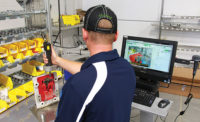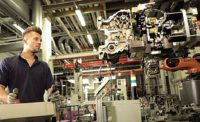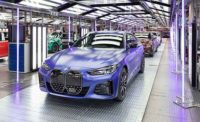The notion of making products close to where you sell them may be coming back into vogue among manufacturers worldwide, but it’s nothing new to Japanese tractor manufacturer Kubota. The company started manufacturing here in 1988, and it has continued to invest heavily in its U.S. presence ever since.
Today, the company has operations in Lincolnshire, IL, to make diesel and gasoline engines; Gainesville, GA, to make subcompact tractors, mowers and utility vehicles; and Jefferson, GA, to make backhoes, loaders and tractor implements. Last April, the company unveiled a new, $50 million headquarters facility in Grapevine, TX. That same month, the Gainesville operation, Kubota Manufacturing of America Corp. (KMA), opened a new assembly facility—its third—just three miles from its original campus. The 502,000-square-foot facility will produce Kubota’s RTV line of utility vehicles. The facility will be able to produce 75,000 vehicles annually.
Recently, we spoke with Brian Arnold, KMA’s vice president and chief manufacturing officer, to talk tractor assembly, lean and poka-yoke.
ASSEMBLY: Tell us more about the new facility in Gainesville. What did you do differently?
Arnold: When we launched the RTV utility vehicle in 2004, the initial production volume was very low, so we just produced it in one of our existing buildings here in Gainesville. Later, in 2007, we repurposed an existing facility for RTV production, but demand grew so much that we had to build an even bigger facility.
We really focused on our Kubota Production System. Our goal was to reduce lead time, from customer order, through manufacturing, to shipping. We set up the new facility so the parts and product flows are very visible. We really streamlined the process.
Before, we started with a makeshift line in an existing building, so the flow was not so good. With the new facility, the flow has improved dramatically.
We also invested in technology. The new facility has two state-of-the-art paint systems that were developed just for the RTV product.
On the assembly line, we invested in torque-control tools and DC electric tools. We also integrated poka-yoke, which is the Japanese term for mistake-proofing, throughout the new facility.
ASSEMBLY: Can you give US an example of poka-yoke on your assembly line?
Arnold: There’s a subassembly process that feeds the main assembly line for the RTV. At one station, it’s critical that several different fasteners are installed at the correct torque. These are safety-critical joints.
When a subassembly arrives at this station, a fixture locks it in place. The fixture will not release the subassembly to the next station unless the specified torques have been reached. The operator can’t pass a mistake to the next process.
Mistake-proofing has been a challenge. As we’ve grown, we’ve brought in a lot of new workers. Kubota is known for quality products. To maintain a high level of quality, you have to design it into your process. You can only train somebody so much. Ultimately, it comes down to having a great process that’s repeatable. That’s the only way we can guarantee quality.
ASSEMBLY: You’ve been with the company for more than 22 years. How has Kubota’s operation changed over that time?
Arnold: When I started, there were about 200 people, and we were in one small building. Now, we have 2,700 people. We’re no longer a small business!
When I started, Kubota was basically a Japanese-managed company. All the key managers were Japanese. But, the company’s intent was always to train local staff. Today, pretty much every department is led by local management. We still have a Japanese president, but more responsibility has been placed on local staff.
The U.S. operation was always important to [the parent company in] Japan, but now, in terms of units, we produce 50 percent of all the products Kubota sells in the U.S. We’re a key part of the whole supply chain for Kubota. Failure is not an option!
ASSEMBLY: What assembly technologies have made the biggest impact on your operation?
Arnold: We used to build in lots and then do model changeovers. Today, because we produce such a diversity of products, each of our assembly lines is now a fully sequenced operation. We’re even more sequenced than an automotive assembly plant. If you go to a Toyota plant, you might see an Avalon and a Camry on the same line, but we’re producing lawn tractors and subcompact BX tractors on the same assembly line. Those are dramatically different products.
To do that, you need a very good sequencing system for your parts supply. Pick-to-light systems enable us to be that flexible. Every assembly and weld process relies on pick-to-light systems. We have thousands of them.
ASSEMBLY: Tell us more about Kubota’s 5-GEN training system.
Arnold: The goal of 5-GEN is to train people to identify and eliminate waste. It was originally designed for supervisors, but now we’re giving that training to lead people and even line workers so they can take ownership of their processes, identify waste, and come up with ways of doing things easier.
A lot of kaizen improvements have come out of 5-GEN.
ASSEMBLY: Can you give us an example?
Arnold: We’re always doing kaizen. For example, on the line producing loader implements, we can now go from the assembly line straight onto the delivery truck, with no buffer at all. There was a lot of kaizen activity to make that happen. We had to eliminate any rework or work in process. We did a lot of work on preventing defects.
ASSEMBLY: What challenges does the company expect in the future?
Arnold: We’re constantly working to reduce lead time. That’s because the needs of our dealers can change dramatically depending on weather conditions and other factors. They can’t forecast their product sales for six months. They want to be able to put in their orders and get product as quickly as possible.
Internally, we can handle that, but a big challenge is our supplier base. Everybody is busy now. So the challenge is how to develop and retain a supplier base that can meet our needs for flexibility and responsiveness.
The other big challenge is to find and retain skilled labor. We do a lot of training internally, but it’s still difficult. As much as we’ve grown and with the unemployment rate being what it is, finding and keeping good workers is not going to get any easier.





